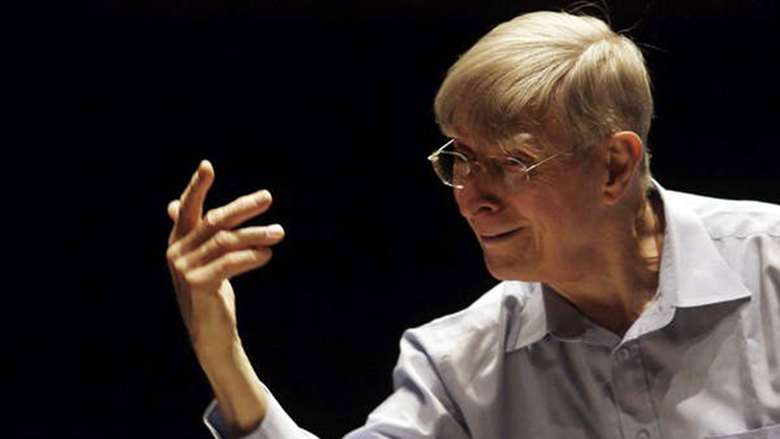Bruckner's Symphony No 8, an introduction by Herbert Blomstedt
Monday, February 19, 2024
Herbert Blomstedt considers a work that’s nothing short of miraculous

When I was 13 or 14 years old I first heard the music of Bruckner – it was his Fourth Symphony, in Gothenburg. I was fascinated immediately and the sound of the orchestra completely mesmerised me. My older brother and I walked home through the parks of the city, trying to remember all the themes. It was so different from all the other music we had heard.
As for the Eighth Symphony, I had no real relationship with the piece until I first conducted it myself, in Oslo in the 1960s. I was fortunate in having a very eager orchestra there, and a wonderfully supportive radio station involved with the concerts. Still, I completely understood why Hermann Levi could not make anything of the piece. This was so different from everything Bruckner had done so well. This symphony requires a bit more work, more analysis and a willingness to be open and led into this foreign country.
The entire piece is very organic. The harmonic world transports you: follow the modulations and enjoy them
There is also the question of editions. Eugen Jochum, one of my great models, had conducted from earlier ones, which were all that were available to him, but I believe there is no perfect edition – neither Robert Haas nor Leopold Nowak. I have a number of performances of the Eighth planned in the years ahead, and I eagerly await Paul Hawkshaw’s new edition of Bruckner’s own revised version.
The Seventh Symphony begins with a long melody, but the opening of the Eighth is nothing like that – it’s notes and silence, bits and pieces, with none of the enchantment. Then there’s a huge contrast with the second theme, which features one of those two-plus-three melodies that so fascinated Bruckner. The first version of this piece was dominated by the brothers Josef and Franz Schalk, who were very faithful students of the composer, but not happy with the original ending of the first movement – a great triumph, fortissimo, after a big C major build-up. They convinced Bruckner to end it pianissimo instead, a light blown out, so as not to pre-empt the triumph of the finale. There’s a challenge to performers here, a temptation to ritardandos. It’s a great emotional experience to play this piece.
Very correctly and bravely, using Beethoven’s Ninth as a model, Bruckner now puts the Scherzo second, following the broad and serious opening movement. There is a new Trio in the revised version of the symphony, in A flat, including – for the only time in Bruckner’s oeuvre – three harps.
The peak of a Bruckner symphony varies from one work to the next. In this one, it’s really felt in the third-movement Adagio: the build-ups are so convincing, but making it work is a major feat. The movement is a miracle – slow, but not too slow, never dragging. There’s another typical Bruckner rhythm two bars before the first melody: that two-plus-three combination again. The melody begins with one long note. The second theme, in sixths, is typical Bruckner again. There are strong echoes of the opening movement here – the entire piece is very organic. The harmonic world transports you: follow him in his modulations and enjoy them.
In the finale, Bruckner included some optional cuts, and I hope they feature as optional in the new critical edition. Up until now I have preferred the Haas edition, for strict musical reasons, because he opens up 10 bars in the Adagio and 50 bars in the finale – where otherwise cuts can create many problems of tempo. Haas believed that the Schalks coerced Bruckner into more cuts than he had anticipated, so his version is very close to the first version.
The composer’s response to the Schalks was to accept the cuts for now, but to state, ‘This does not apply to future times.’ I believe the ‘Bruckner of future times’ deserves the full length and balance: cuts mean the body has a finger missing, or a whole hand, or a whole arm, and omitting 50 bars is a bit excessive. The end of the last movement, in triumphant C major, includes melodies from all four movements. They are all there, even the Adagio melody, embedded in other musical lines. As in Beethoven, everything develops out of a single bud that the composer created.
Throughout his life, Bruckner was surrounded by enemies – front and back, above and below; but he still went his own way and found wonderful solutions to the musical problems he created for himself. You have to identify with this music, otherwise you cannot perform it. It takes ten times as long to study, as compared with Beethoven or Mozart, but it’s worth it. It’s a miracle, how it’s possible to put all this together – and crazily ambitious, asking the impossible of musicians and also of listeners. This is a miracle symphony.
Interview by Michael McManus
This article originally appeared in the January 2024 issue of Gramophone. Never miss an issue of the world's leading classical music magazine – subscribe today

















